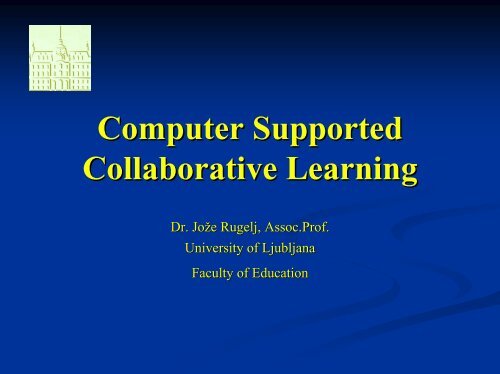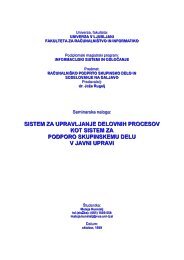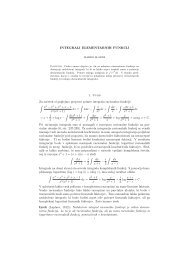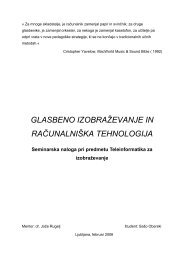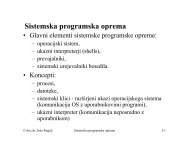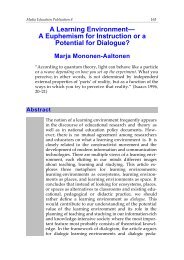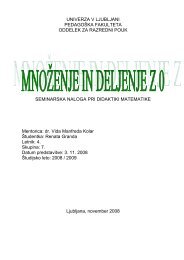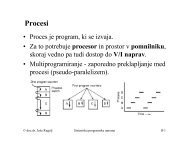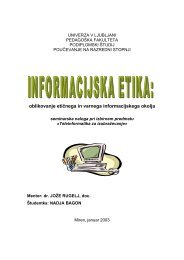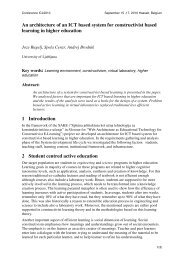Computer Supported Collaborative Learning - Hrast
Computer Supported Collaborative Learning - Hrast
Computer Supported Collaborative Learning - Hrast
Create successful ePaper yourself
Turn your PDF publications into a flip-book with our unique Google optimized e-Paper software.
<strong>Computer</strong> <strong>Supported</strong><br />
<strong>Collaborative</strong> <strong>Learning</strong><br />
Dr. Jože Rugelj, Assoc.Prof.<br />
University of Ljubljana<br />
Faculty of Education
• The theoretical foundation for collaborative learning<br />
is social constructivism.<br />
• One foundational premise in SC is that children<br />
actively construct their knowledge rather than simply<br />
absorbing ideas spoken at them by teachers.<br />
• They assimilate new information to simple, pre-<br />
existing notions and modify their understanding in the<br />
light of new data.
• Instruction in this context is a process of supporting<br />
that construction rather than communicating<br />
knowledge.<br />
• Most SC models stress the need for collaboration<br />
among learners.<br />
• One Vygotskian notion, that has significant<br />
implications for peer collaboration, is that of the 'Zone<br />
of Proximal Development.'
• ZPD is defined as "the distance between the actual<br />
developmental level as determined by independent problem<br />
solving and the level of potential development as determined<br />
through problem solving under adult guidance or in<br />
collaboration with more capable peers" (Vygotsky(<br />
Vygotsky, , 1978),-<br />
• Through a process of 'scaffolding' a learner can be extended<br />
beyond the limitations of physical maturation to the extent that<br />
the "the development process lags behind the learning process".
• The broadest definition of 'collaborative learning' is that it is a<br />
situation in which two or more people learn or attempt to learn<br />
something together.<br />
• two or more may be interpreted as a pair, a small group, a class, a<br />
community, a society and all intermediate levels.<br />
• learn something may be interpreted as "follow a course", "study<br />
course material", "perform learning activities such as problem<br />
solving", "learn from lifelong work practice", ....<br />
• together may be interpreted as different forms of interaction:<br />
face-to<br />
to-face or computer-mediated, mediated, synchronous or not, frequent<br />
in time or not,
• Intuitively, a situation is termed 'collaborative' if peers are<br />
more or less at the same level, can perform the same actions,<br />
have a common goal and work together.<br />
• The second criterion is that one generally expects collaborating<br />
partners to have common goals.<br />
• The third criterion concerns the degree of division of labour<br />
among group members. Collaboration and cooperation are<br />
used distinctively according the degree of division of labour. In I<br />
cooperation, partners split the work, solve sub-tasks<br />
individually and then assemble the partial results into the final<br />
output. In collaboration, partners do the work 'together'.
• Shared knowledge is fundamentally constructed<br />
through collaboration between persons.<br />
• Different forms of interaction – that can be extended<br />
in time and space by various media and ICT tools –<br />
are the means by which people both collaboratively<br />
construct beliefs and meanings, and state differences<br />
between them.<br />
• Psychological, social and cultural processes within<br />
groups of collaborating people are the key factors in<br />
determining whether ICT tools will be accepted and<br />
successful.
• Collaboration that is mediated by ICT may proceed<br />
synchronously or asynchronously.<br />
• Another distinction concerns implicit versus explicit<br />
communication. The former refers to collaboration<br />
through use of shared information resources, such as<br />
documents, images and spreadsheets, whilst the latter<br />
is explicit communication among collaborators using<br />
audio and/or video channels, or just simple text<br />
messages.
• Appropriate communication media need to be<br />
selected for collaborative knowledge construction .<br />
• Factors that affect the selection:<br />
• characteristics of a task;<br />
• availability of telematics tools to all members of the group;<br />
• intended period of interaction;<br />
• inertia involved in switching to more appropriate media;<br />
• the ability to extend interaction in time and space.<br />
• Factors which contribute to richness are:<br />
• interactivity (the speed of reaction)<br />
• multiple cues (verbal, intonation, proxemic, , and kinetic)<br />
• language-variety (numbers, natural language, symbols, images)<br />
• socio-emotional cues (social presence, feelings)
• ICT software tools for explicit communication:<br />
•Conferencing system: questions for tutor, other<br />
participants, or experts, answers to questions, open<br />
discussions (moderated), informal chat.<br />
•Email Email<br />
•Internet Internet Relay Chat, MUD(Multi-User User Dimensions)<br />
•Low-cost desktop A/V conferencing tools: CU-<br />
SeeMe or NetMeeting conferencing tool, ISDN<br />
conferencing.
• ICT software tools for implicit communication:<br />
•Shared Shared workspace (BSCW)<br />
•Knowledge tree<br />
•Shared Shared whiteboard<br />
•Shared Shared use of software tools (word processor,<br />
spredsheets, , graphical editor)<br />
•<strong>Learning</strong> <strong>Learning</strong> management system<br />
•<strong>Learning</strong> <strong>Learning</strong> content management system
• Developments in ICT are starting to make it possible to use the<br />
tools for assisting the process of learning beyond the<br />
boundaries of the classroom.<br />
• In addition, their use will start to prepare learners for<br />
participation in a networked, information society where<br />
knowledge is the most critical resource for personal, social and<br />
economical development.
• School children and students increasingly need to<br />
acquire the individual and the group learning skills for<br />
use in learning societies and learning organisations.<br />
• They need to acquire the skills that enable them to<br />
cope with an abundance of information in order to<br />
build knowledge and thus learn from the knowledge<br />
acquired.
• <strong>Computer</strong>-supported<br />
collaborative learning requires<br />
teachers and students to adopt an educational<br />
philosophy that focuses on “knowledge<br />
building”<br />
rather than “knowledge<br />
reproduction” as the main<br />
learning activity.<br />
• This requires both teachers and students to believe<br />
in and trust a learning style that involves active,<br />
self-regulated<br />
regulated, constructive and contextualised<br />
learning by groups of students more or less<br />
independently.
• However, , not every student or teacher is used to this<br />
way of learning and for many it was not easy to learn<br />
together with other students. . In addition, , it is not easy<br />
to integrate this new educational philosophy with<br />
existing philosophies in schools.<br />
• Although other research has shown that co-operative<br />
operative<br />
learning is effective, if students have common goals<br />
and interests combined with individual accountability,<br />
in reality, , it hardly occurs within existing school<br />
practice.
• ICT support does add value by:<br />
• The easier organisation in the classroom of collaborative<br />
learning.<br />
• Better visibility of collaboration processes involving of all<br />
students.<br />
• Making communication patterns visible and structuring<br />
types of communication.<br />
• Making types of thinking visible and organising enquiry-<br />
based learning.<br />
• <strong>Learning</strong> to build knowledge and meaning collectively.<br />
• Building connections with practice; and opening new forms<br />
of collaboration with other classrooms, schools, nations,<br />
and other partners like museums and universities.
• Teachers and students do like to work through computer<br />
supported collaborative learning, but it is not easy to<br />
integrate new didactical practices into existing curricula.<br />
International<br />
exchanges seem to have a positive effect on the<br />
motivation of both students and teachers.<br />
• Teachers<br />
do not have the time for support or preparation of<br />
assignments and questions for use within a computer<br />
supported collaborative learning.<br />
• There<br />
are not enough didactical materials, , or examples of<br />
good practice to help them fulfil their new roles.
• Various<br />
positive effects can be found in computerc<br />
supported collaborative learning environments :<br />
•There<br />
is relatively consistent evidence of students showing<br />
more interest in collaborative learning.<br />
•The<br />
practises of learning and instruction change<br />
considerably.<br />
•Students<br />
work in a more self-regulating<br />
way.<br />
•The<br />
amount and quality of social interaction between<br />
teachers and students increase.<br />
•Students<br />
develop skills for using information technology<br />
and basic knowledge acquisition. They learn to access<br />
extended sources of information and motivation increase.
• There<br />
are<br />
significant advantages in using CSCL in<br />
mathematics and languages, and in process-oriented<br />
oriented<br />
measures like the quality of question raised and depth of<br />
explanation.<br />
• The suitability of the software is critical to CSCL.<br />
• There<br />
is no evidence that multimedia elements have<br />
pedagogical value without carefully planned instructional<br />
strategies and adequately educated teachers.
• Unlike the scientific communities, practising teachers<br />
do not consider highly the role of CSCL within future<br />
learning environments. This is partly due to its<br />
novelty, but also highlights that the theoretical and<br />
practical principles of computer-supported<br />
collaborative learning are too immature to be adopted<br />
as practical educational reforms.<br />
• Nevertheless, , a form of CSCL would be the most<br />
desired way to implement desired changes in<br />
educational practises like changing the educational<br />
philosophy of teachers and students.
Key Recommendations<br />
• There is a need for theoretically well-grounded<br />
development of<br />
CSCL practises and tools that are embedded in a practical<br />
educational context.<br />
• Effective infrastructures need to be established to ensure<br />
computer and computer networks are optimally utilised.<br />
Specialist IT technicians should be responsible for maintenance<br />
to enable teachers to concentrate on teaching.<br />
• Any technology needs to be adaptable to the instructional needs<br />
of teachers and to the daily realities of classroom life.<br />
• Support is also needed for the creation of electronic<br />
communities for teachers, which can aid the development of<br />
new learning methods and help establish learning communities.
• To effectively implement computer-supported<br />
collaborative learning in schools, financial support is<br />
needed for:<br />
•Adequate<br />
teacher training.<br />
•Extra<br />
hours for teachers to design assignments and<br />
questions.<br />
•<strong>Computer</strong>s<br />
and software.<br />
•Pedagogical<br />
support.<br />
• School libraries needs to become multimedia centres,<br />
central to schools in order to promote individual<br />
learning and small group work with librarians trained<br />
to be guides and tutors in the search for information
• Teachers also need training to develop technical<br />
expertise and know-how<br />
and to learn to be more<br />
effective guides and tutors.<br />
• Opening schools to activities beyond school time<br />
could facilitate the participation of Institutions in the<br />
educational community.<br />
• Educational research and the policy of national<br />
school institutions must be integrated as current<br />
research is artificially constructed and results in<br />
outcomes that scarcely affect changes.


